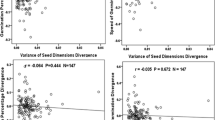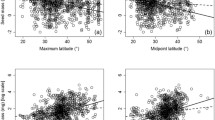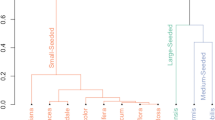Abstract
This study examined seed size distribution, and seed size in relation to phylogeny, growth form and longevity, where seed size is expected to be approximately of a log-normal frequency distribution and correlate dwith phylogeny, growth form and longevity. We made use of a data set of 229 species from alpine meadow on the east of the Tibetan plateau. Species spanned 104 range of seed size, and the frequency of seed mass classes on a logarithmic scale produced an approximately normal distribution, but largely shifted towards smaller-sized seeds compared to those of the temperate zone and the tropics. It was evident that seed size was strongly related to phylogeny, where order, family, genus and species accounted for 2%, 32.9%, 48.9% and 16.2% of total variation in log seed mass. However, both growth form and longevity did not account for variation in log seed mass, which was opposite to the previously reported patterns of trait correlation. The implications of our results are discussed.
Similar content being viewed by others
References
Ackerly D.D. &Reich P. (1999): Convergence and correlations among leaf size and function in seed plants: A comparative test using independent contrasts.Amer. J. Bot. 86: 1272–1281.
Angiosperm Phylogeny Group (1998): An ordinal classification for the families of flowering plants.Ann. Missouri Bot. Gard. 85: 531–553.
Augspurger C.K. (1984): Light requirements of neotropical tree seedlings: a comparative study of growth and survival.J. Ecol. 72: 777–795.
Baker H.G. (1972): Seed weight in relation to environmental conditions in California.Ecology 53: 997–1010.
Bondeau A., Kicklighter D.W. &Kaduk J. (1999): Comparing global models of terrestrial net primary productivity (NPP): importance of vegetation structure on seasonal NPP estimates.Global Change Biol. 5: 35–45.
Editorial Committee of Chinese Plant Records (1998):Chinese plant records. Science Press, Beijing.
Foster S.A. &Janson C.H. (1985): The relationship between seed size and establishment conditions in tropical woody plants.Ecology 66: 773–780.
Foster S.A. (1986): On the adaptive value of large seeds for tropical moist forest trees: a review and synthesis.Bot. Rev. 52: 260–299.
Geritz S.A.H. (1998): Co-evolution of seed size and seed predation.Evol. Ecol. 12: 891–911.
Geritz S.A.H., Meijden E.V.D. &Metz A.J. (1999): Evolutionary dynamics of seed size and seedling competitive ability.Theor. Populat. Biol. 55: 324–343.
Harper J.L., Lovell P.H. &Moore K.G. (1970): The shapes and sizes of seeds.Annual Rev. Ecol. Syst. 1: 327–356.
Harvey P.H. &Mace G.M. (1982): Comparisons between taxa and adaptive trends. In:King’s College Sociobiology Group (eds.),Current problems in sociobiology, Cambridge University Press, Cambridge, pp. 343–361.
Harvey P.H. &Pagel M. (1991):The comparative method in evolutionary biology. Oxford University Press, Oxford.
Harvey P.H., Read A.F. &Nee S. (1995): Why ecologist need to be phylogenetically challenged.J. Ecol. 83: 535–536.
Herrera C.M. (1992): Historical effects and sorting processes as explanations for contemporary ecological patterns: character syndromes in Mediterranean woody plants.Amer. Naturalist 140: 421–446.
Hodgson J.G. &Mackey J.M.L. (1986): The ecological specialization of dicotyledonous families within a local flora: some factors constraining optimization of seed size.New Phytol. 104: 497–515.
Hughes L., Dunlop M., French K., Leishman M., Rice B., Rodgerson L. &Westoby M. (1994): Predicting dispersal spectra: a minimal set of hypotheses based on plant attributes.J. Ecol. 82: 933–950.
Jurado E., Westoby M. &Nelson D. (1991): Diaspore weight, dispersal, growth form and perenniality of Central Australian plants.J. Ecol. 79: 811–830.
Keeley J.E. (1991): Seed germination and life history syndromes in the California chaparral.Bot. Rev. 57: 81–116.
Kelly C.K. (1995): Seed size in tropical trees: a comparative study of factors affecting seed size in Peruvian angiosperms.Oecologia 102: 377–388.
Kelly C.K. (1996): Seed mass, habitat conditions and taxonomic relatedness: a re-analysis of Salisbury (1974).New Phytol. 135: 169–174.
Kisdi É. &Geritz S.A.H. (2001): Evolutionary disarmament in interspecific competition.Proc. Roy. Soc. London B 268: 2589–2594.
Leishman M.R. &Westoby M. (1994): Hypotheses on seed size: tests using the semiarid flora of western New South Wales, Australia.Amer. Naturalist 143: 890–906.
Leishman M.R., Westoby M. &Jurado E. (1995): Correlates of seed size variation: a comparison among five temperate floras.J. Ecol. 83: 517–530.
Lord J., Egan J., Clifford T., Jurado E., Leishman M., Williams D. &Westoby M. (1997): Larger seeds in tropical floras: consistent patterns independent of growth form and dispersal mode.J. Biogeogr. 24: 205–211.
Lord J., Westoby M. &Leishman M.R. (1995): Seed size and phylogeny in six temperate floras: conservatism, and adaptation.Amer. Naturalist 146: 349–364.
Mazer S.J. (1989): Ecological, taxonomic and life history correlates of seed mass among Indiana dune angiosperms.Ecol. Monogr. 59: 153–175.
Mazer S.J. (1990): Seed mass of Indiana Dune genera and families: taxonomic and ecological correlates.Evol. Ecol. 4: 325–357.
McKitrick M.C. (1993): Phylogenetic constraint in evolutionary theory: has it any explanatory power?Annual Rev. Ecol. Syst. 24: 307–330.
Onipchenko V.G., Semenova G.V. &van der Maarel E. (1998): Population strategies in severe environments: alpine plants in the northwestern Caucasus.J. Veg. Sci. 9: 27–40.
Primack R.B. (1987): Relationship among flowers, fruit and seeds.Annual Rev. Ecol. Syst. 18: 409–430.
Rees M. &Westoby M. (1997): Game-theoretical evolution of seed mass in multi-species ecological model.Oikos 78: 116–126.
Rees M. (1993): Trade-offs among dispersal strategies in British plants.Nature 366: 150–152.
Rees M. (1995): EC-PC comparative analyses?J. Ecol. 83: 891–893.
Salisbury E.J. (1942):The reproductive capacity of plants. Bell, London.
SAS Institute (1991):SAS/STAT users guide. Release 6.04. SAS Institute, Cary.
Silvertown J.M. (1981): Seed size, lifespan and germination date as co-adapted features of plant life history.Amer. Naturalist 118: 860–864.
Smith C.C. &Fretwell S.D. (1974): The optimal balance between size and number of offspring.Amer. Naturalist 108: 499–506.
Stebbins G.L. (1974):Flowering plants: evolution above the species level. Harvard University Press, Cambridge.
Telenius A. &Torstensson P. (1991): Seed wings in relation to seed size in the genus Spergularia.Oikos 61: 216–222.
Thompson K. &Grime J.P. (1979): Seasonal variation in the seed banks of herbaceous species in ten contrasting habits.J. Ecol. 67: 893–921.
Thompson K. &Rabinowitz D. (1989): Do big plants have big seeds?Amer. Naturalist 133: 722–728.
Thompson K. (1984): Why biennials are not as few as they ought to be.Amer. Naturalist 123: 854–861.
Thompson K. (1987): Seeds and seed banks.New Phytol. 106(suppl.): 23–34.
Westoby M., Jurado E. &Leishman M.R. (1992): Comparative evolutionary ecology of seed size.Trends Ecol. Evol. 7: 368–372.
Westoby M., Leishman M.R. &Lord J.M. (1995): On misinterpreting the ‘phylogenetic correction’.J. Ecol. 83: 531–534.
Author information
Authors and Affiliations
Corresponding author
Rights and permissions
About this article
Cite this article
Zhang, S.T., Zhen Du, G. & Chen, J.K. Seed size in relation to phylogeny, growth form and longevity in a subalpine meadow on the east of the Tibetan plateau. Folia Geobot 39, 129–142 (2004). https://doi.org/10.1007/BF02805242
Received:
Revised:
Accepted:
Issue Date:
DOI: https://doi.org/10.1007/BF02805242




